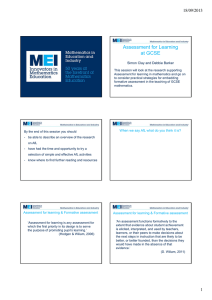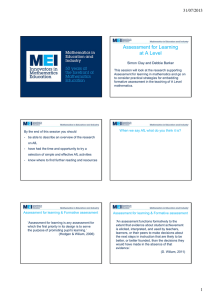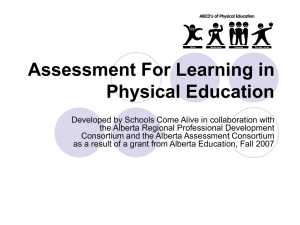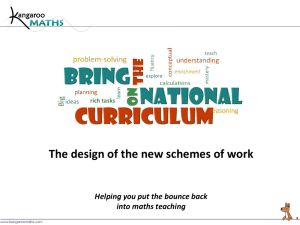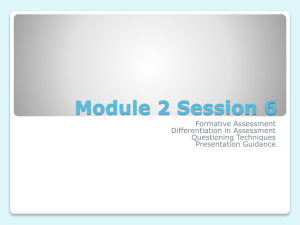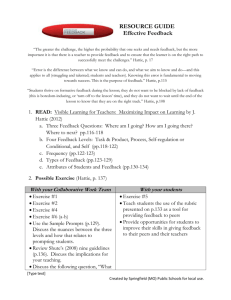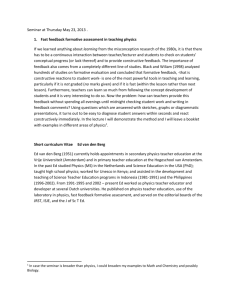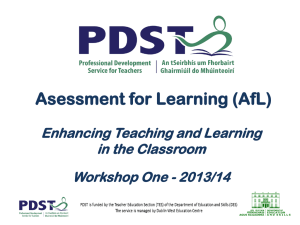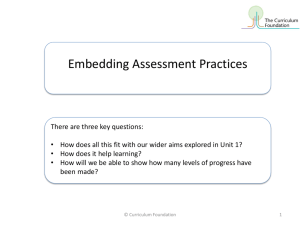Document 10489493
advertisement
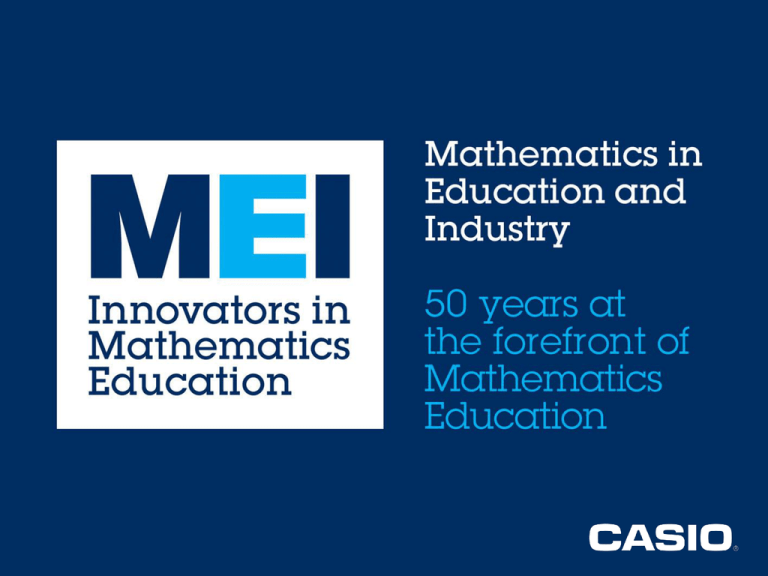
Assessment for Learning with examples from GCSE & A-level Simon Clay and Debbie Barker This session will look at the research supporting Assessment for Learning in mathematics and go on to consider practical strategies for embedding formative assessment in the teaching of GCSE and A-level mathematics. By the end of this session you should - be able to describe an overview of the research on AfL - have had the time and opportunity to try a selection of simple and effective AfL activities - know where to find further reading and resources When we say AfL what do you think it is? Assessment for learning & Formative assessment ‘Assessment for learning is any assessment for which the first priority in its design is to serve the purpose of promoting pupil’s learning.’ (Hodgen & Wiliam, 2006) Assessment for learning & Formative assessment ‘An assessment functions formatively to the extent that evidence about student achievement is elicited, interpreted, and used by teachers, learners, or their peers to make decisions about the next steps in instruction that are likely to be better, or better founded, than the decisions they would have made in the absence of that evidence.’ (D. Wiliam, 2011) The 5 key formative assessment strategies The three ‘roles’ The three ‘processes’ Where the student is going Where the student is right now How to get there Teacher 1 Clarifying learning intentions and sharing criteria for success 2 Engineering effective classroom discussions, activities and tasks that elicit evidence of learning 3 Providing feedback that moves students forward Peer Understanding and sharing learning intentions and criteria for success Understanding learning Student intentions and criteria for success 4 Activating students as instructional resources for one another 5 Activating students as the owners of their own learning Taken from ‘Assessment for Learning: why, what and how?’ by Dylan Wiliam (2009) Where they are going Where they are going Clear intended outcomes Where they are going Clear intended outcomes Clear success criteria Where they are now Where they are going Clear intended outcomes Clear success criteria Where they are now Where they are going Assess starting point(s) Clear intended outcomes Gather evidence Clear success criteria Where they are now Where they are going Assess starting point(s) Clear intended outcomes Gather evidence Clear success criteria Use experience and knowledge Where they are now How to get there Where they are going Assess starting point(s) Clear intended outcomes Gather evidence Clear success criteria Use experience and knowledge Where they are now Assess starting point(s) Gather evidence Use experience and knowledge How to get there Where they are going Plan activities which move students on Clear intended outcomes Assessing progress Clear success criteria Provide feedback which moves students on Describe to the person next to you what you hope the rest of the session will help you to achieve Feedback ‘Three types of feedback are essential…student to teacher…teacher to student ….between students’ (Hodgen & Wiliam, 2006) ‘Feedback should always cause thinking’ (Wiliam, 2011) Questioning ‘…using mathematical questions as prompts and devices for promoting students in thinking mathematically, and thus becoming better at learning and doing mathematics.’ (Watson & Mason, 1998) Questioning for useful and immediate feedback Questioning for useful and immediate feedback Questioning for useful and immediate feedback Questioning for useful and immediate feedback or or Questioning for useful and immediate feedback Questioning for useful and immediate feedback Sometimes, always or never false? Classroom talk ‘Talking is central to … teaching mathematics formatively’ (Hodgen & Wiliam, 2006) Classroom talk “Three of a kind” from Bowland Maths The picture shows three Click here to view the image regular hexagons. What is the same and what is different about them? What can you say about the lengths, angles, sizes, areas, symmetry? Anything else? Classroom talk Classroom talk 2 3 1 1 1 1 ... 4 4 3 4 Taken from ‘Proof without Words’ by Roger Nelsen Reviewing progress Reviewing ‘progress’ Please tell us one way your understanding of AfL has altered. OR Please tell us one way of improving this session. Further reading Dylan Wiliam Embedded formative assessment ISBN-10: 193400930X Malcolm Swan http://map.mathshell.org.uk/materials/index.php Write down one thing you are going to do before the summer holidays as a result of this session.
